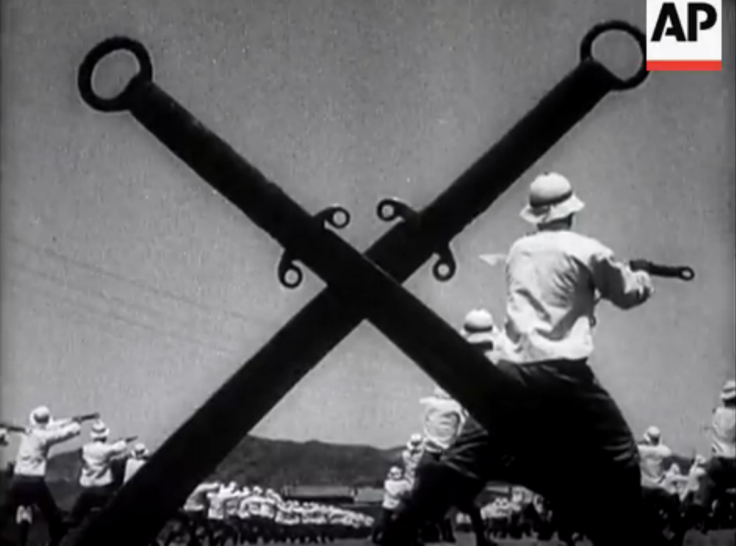
“In the west, Asian martial arts are everywhere. They are part of the texture of popular consciousness. Nonetheless I want to argue that they remain marginal. That is to say, although Westerners may see them often, and all over the place, they are not simply the norm.”
-Paul Bowman, “the Marginal Movement of the Martial Arts: From the Kung Fu Craze to Master Ken.” 2015.
Introduction
Students of martial arts studies stand at a perpetual crossroads. It springs from the very nature of our subject. A great many of us are current or former martial artists. We have an intimate understanding of the embodied physicality of these practices. As much as I like talking about the history of Wing Chun, I will be the very first person to say that if you want to understand what the art actually is, don’t start by reading a book or blog post about it. Not even one written by me. Go and do it. Experience the actual system. Examine how it makes you feel.
At the same time I have to wonder why you are asking me about Wing Chun in the first place? As a historian I can tell you that it was a pretty obscure art back in 1949. Chances are good that you first encountered this style through the media, either on TV or film. That is just fine as the martial arts, while a sensuous experience, have always existed as an aspect of popular culture. That was also the case in historic Japan and China. In those countries commercial visual art (woodblock prints), professional storytellers, printed novels and traveling opera performers, spread the stories of various heroes just as effectively as film or videogames do today.
This is why martial arts studies needs to remain an interdisciplinary research area. It is unlikely that any single methodological toolbox can reveal all that this body of practices has to offer. On the one hand no less an authority than Douglas Wile has argued that Universities have an unprecedented opportunity to become involved in teaching, preservation and analysis of actual martial arts systems and traditions.
Still, we would be foolish to assume that the physical practice of the martial arts is a self-interpreting process. The popular literature is littered with experts, spiritual gurus and ethno-nationalist propagandists all of whom would like assist us in discovering the “true” meaning of our practice. How could it be otherwise? The martial arts exist as social institutions, and social power is always somewhat fungible in nature. That makes it a valuable and contested resource.
This realization should also spark a moment of self-reflection. Images of these practices were introduced to us through an (often media driven) social discourse long before we started to practice them. And while our understanding of their nature no doubt grew exponentially as we engaged with them, how do these “first impressions” continue to color our understanding of our practice? How do they help to explain why some sorts of individuals, and not others, tend to be drawn to the martial arts in the first place?
We probably cannot understand our personal experiences within the martial arts, let alone their broader social impact, if we ignore the discourses which bring new students to the school door. This is not simply a theoretical question. For anyone interested in the health and future survival of the traditional martial arts it is a vital topic.
Readers interested in exploring this subject more deeply would be well advised to carefully consider Paul Bowman’s recent conference paper from which the introductory quote was drawn. I suspect that as we look back on the development of martial arts studies it will be remembered as one of the more important papers given this year, particularly for those interested in the global spread and appropriation of the martial arts.
This paper is also a fun read. It diverges from the (ever serious) mainstream discussion of history and film, and instead takes a look at the evolution of martial arts humor in the West. As Bowman reminds us, humor is a powerful tool of analysis because it points to deeply held, and widely shared, cultural frameworks. If you want to know what the public at large thinks about the martial arts, start by considering what they find funny. This often reveals more nuanced views than a simple opinion survey might be able to uncover.
Unfortunately Bowman notes that the public spends a lot of time laughing at martial artists, rather than with them. While these systems have successfully spread themselves throughout Western society, with terms like “Kung Fu” and “Ninja” now being part of popular culture, they always seem to lose out in the realm of respectability politics.
Consider the following. No parent needs to explain or rationalize their decision to send a child to a summer sports camp, or to push them to excel in gymnastics or basketball. But parents supporting their children in a Judo class or Kickboxing tournament generally come well-armed with a litany of justifications for their recreational choices. It keeps my kids active, it teaches them to fend for themselves, it prepares them for the ‘real world,’ and (my personal favorite) it ‘builds character.’ Basketball probably does a lot of the same things. But no one feels the need to concoct elaborate justifications for allowing their kid to try out for the school team. It is just a normal and expected part of childhood. And it is fun.
This is where the martial arts run into trouble. For all of their name recognition, Bowman notes that they remain separated from the norms and hegemonic discourses that define mainstream western society. Ergo the constant need to justify them as vehicles for other values that society has deemed to be acceptable. In that sense our justifications of our practices are very revealing. They speak to the sorts of questions and concerns that our neighbors might have when they learn that we have just signed a child up for a Brazilian Jiu Jitsu class.
The distance between the perceived cultural place of the martial arts and society’s dominant value systems creates a space of puzzlement, tension, and sometimes fear among non-martial artists. Humor is important as it can be used to either subtly disarm these emotions, or to further marginalize the “deviant” behavior.

A Judo match between a British and German competitors. Taken from a vintage newsreel. 1932.
Towards a Media Archeology of Martial Arts Studies: Judo, Kendo and the Dadao on Film
While I agree with the main thrust of Bowman’s argument I would like to push its application in a more historical direction. His investigation of the evolution of martial arts humor seems to begin in 1974 with the release of the now iconic disco hit ‘Everybody was Kung Fu Fighting.’ Bowman points out that the meteoric rise of this song through the charts marked, in many ways, the high-water mark of the ‘Kung Fu Craze’ of the early 1970s.
Touched off by grind house Kung Fu films (especially those by Bruce Lee), this interest in the Chinese martial arts had been seen as edgy, counter-cultural and somewhat dark. This same view was even shared by some in the mainstream martial arts world where Bruce Lee’s movies did not always make a good impression on the more conservative practitioners of the Budo arts. Yet by the middle of the 1970s the Chinese styles seem to have accomplished what it took the Japanese arts decades to do. They too became fixtures in the pop culture landscape, and ‘Kung Fu’ quickly joined ‘Karate’ and ‘Judo’ as household words. Krug places an acceleration in the cultural appropriation of the Asian martial arts as happening in this same time period.
Still, high-water marks foretell an inexorable retreat. As the Chinese martial arts became famous they quickly lost their aura of danger. What had been “dark” and mysterious became just another consumer good.
On Main Streets across America, Kung Fu schools opened their doors to throngs of students looking to recapture Bruce Lee’s magic. The humorous disco hit of 1974 both illustrated and advanced this process. As Bowman puts it “…the song ‘Everybody was Kung Fu Fighting’ participated in the domestication, sanitization, depoliticizing and, ultimately, ridiculing Kung Fu.”
Nor were the Chinese martial arts alone in this. As Bowman points out in the rest of the article, what pop culture humorists tended to latch onto after the 1970s was the exotic “Oriental” nature of the martial arts. The specific culture that gave rise to a given movement tradition (Japan, China, or the Philippines) was less important to western audiences than their essentially “Eastern” nature. While it often irks aficionados that popular songs or TV shows seemed to confuse Chinese and Japanese traditions Bowman notes that this is simply how these things were perceived by audiences in the West.
Yet what sort of pre-history exists behind all of this. Is it really the case that the Kung Fu Craze of the 1970s was a totally unique event? Was this actually the first time that audiences were exposed to the Chinese (or Japanese) martial arts on a massive scale? And can we trace the often uncomfortable humor that surrounds the martial arts to earlier periods, facing very different political and social challenges?
It seems that one of the hurdles facing students of martial arts studies is a periodic amnesia that grips public discussions of many of these topics. It is certainly true that Bruce Lee was a unique figure on the western cultural landscape. Yet he was not actually the first individual to put the Chinese martial arts on film and expose them to national audiences. Likewise, the Japanese martial arts had gained wide exposure on the silver screen long before Samurai films became favorites of the post-WWII art house theater scene.
While I am still mulling over the specific mechanisms behind this unique form of cultural forgetting, I expect that at least some of it has to do with very basic factors dealing with the advertising and marketing of popular culture products. The first step in selling the public something “exciting and totally new” is to never remind them that they have actually been exposed to similar things before. Likewise audiences, in their excitement to be part of a cultural moment, seem inclined to see novelty in places that leave historians and archeologists of popular culture scratching their heads. Ernest Renan famously remarked that a nation is a product of both collective remembering and forgetting. It seems that this same sort of forgetting also plays a part in the construction of “new” social and media discourses.
For many research questions the historical antecedents of a phenomenon may not matter. But in some cases I think they can be quite illuminating. While the past may be consciously forgotten, its path-dependent structure leaves patterns that shape future events in interesting ways. This is certainly the case when we examine media representations of Chinese and Japanese hand combat systems. Consider, for instance, the question of exactly when these things became “humorous” and what that implies about the cultural appropriation of these systems in the west.
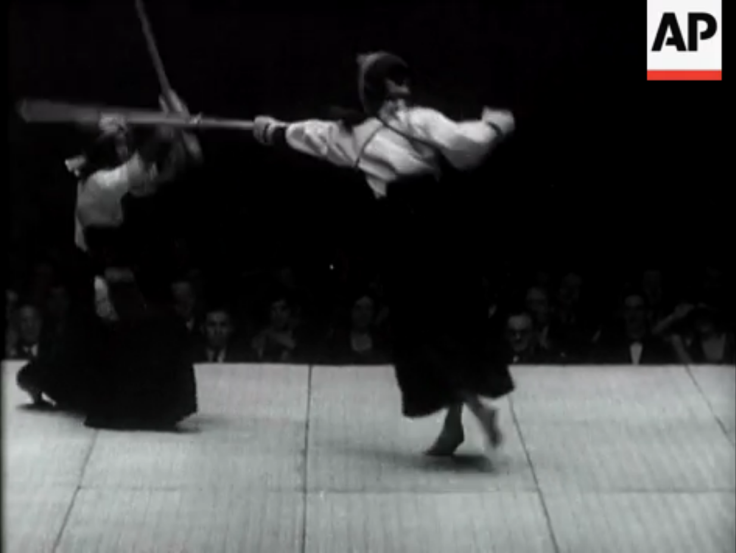
Newsreels: The Japanese and Chinese Martial Arts on Films
Bruce Lee’s iconic ‘Enter the Dragon’ was probably the first Chinese martial art film seen by an entire generation of Americans. Samurai films had been present in the West for a while, yet they generally reached a smaller audience. Kyle Barrowman has reminded us that Western audiences were also exposed to the martial arts in a variety of Hollywood films. Yet it is critical to remember that feature films were not the only places where individuals might be exposed to gripping and informative images of the Asian martial arts.
As I have argued elsewhere, the public display and discussion of the Japanese martial arts goes all the way back to the heyday of the magic lantern display. Heavy glass slides, often delicately painted, along with standardized scripts, provided many late 19th century and early 20th century entertainment seekers with their first glimpse of Jujitsu, Kendo, reformed Judo, Sumo Wrestling and the historic Samurai. Such images and discussions were actually quite popular and widespread almost 70 years before the explosion of the Kung Fu Craze. More importantly for students of the history of popular media, they also helped to establish basic patterns and audience expectations that shaped the developing film industry.
As such we should not be surprised to discover that the Asian martial arts also made early appearances on film. Yet they probably had their greatest impact in the now, mostly forgotten, newsreels that ran before or between the feature films that audiences had come to see.
A few words of orientation may be helpful before proceeding. In an era before television, newsreels were a profoundly important instrument in displaying the sorts of images that would shape public opinion on critical issues. Prior to the fragmentation of the media market they also had the ability to directly speak to large audiences. While old newsreel footage may strike us as quaint, we should not underestimate the effect that it had on shaping people’s views of the world. In fact, newsreels were popular with audiences precisely because (like the magic lantern shows of old) they allowed for a quick glimpse into foreign lands. For students of popular culture and social discourse they are critical, and substantively important, historical documents.
A full survey of all of the martial arts related newsreels put together in the first half of the 20th century is well beyond the bounds of what can be done in a single blog post. But for the purposes of exploring Bowman’s article I would like to ask viewers to consider four specific clips from the late 1920s and early 1930s (an era that is particularly important to my own research). While I briefly describe each of these scenes I cannot directly host them on this on blog. Readers are encouraged to take a few moments to view each of these segments as they are discussed.

We begin with two clips that deal specifically with the Japanese martial arts. These are important because they illustrate many of the trends that Bowman introduced in his paper. Already in the early 1930s the public discussion of the Japanese martial arts was characterized by humor. And much of this bears more than a passing resemblance to the sorts of word-play focusing on cultural discomfort that will once again rise to the surface two generations later.
Perhaps my favorite of these clips is titled “London Sees Thrills of Japanese Sports.” It ran in 1932 and recorded a martial arts exhibition and Judo tournament that pitted competitors from Germany and the UK against each other. While the German fighters managed to score an upset by winning the tournament, most of the footage focused on the exhibition performances.
The footage is historically quite interesting. It includes some Kendo Kata work, and a very spirited exhibition match. Next a member of the audience was selected to try and score a hit against one of the Kendo masters with a Shinai. Perhaps the highlight of the event was a self-defense demonstration in which a woman defended herself against repeated (somewhat bafoonish) attacks. While a trained martial artist, the woman in question was an even better actor. She showed a great ability to play to the audience and give them what they wanted. And that was humor. Note the gales of laughter that can heard as she deals damage to her unfortunate attacker, only to end by powdering her nose while standing over the body of her fallen foe.

In this case the narrator of the film did not make many jokes himself. It seemed to be understood by the audience that what they were seeing was intrinsically funny. And as Bowman suggested, much of that had to do with the western appropriation of Japanese practices and attitudes mixed with questions of gender performance.
In subsequent years the producers of these newsreels would not be so circumspect. As the 1930s progress (see here, here and here) the humor becomes more pronounced and sharper in its focus. Increasingly the narrator takes the lead in articulating and directing the humor. Thus we can almost track the evolution of this particular discourse. Yet by 1932 it seems to have been already firmly established

These newsreels are also informative in that they did not confine themselves to domestic subjects. Like the magic lantern shows that preceded them they functioned as a form of virtual tourism for a public that was hungry for travel and worldly knowledge yet firmly grounded in their own lives.
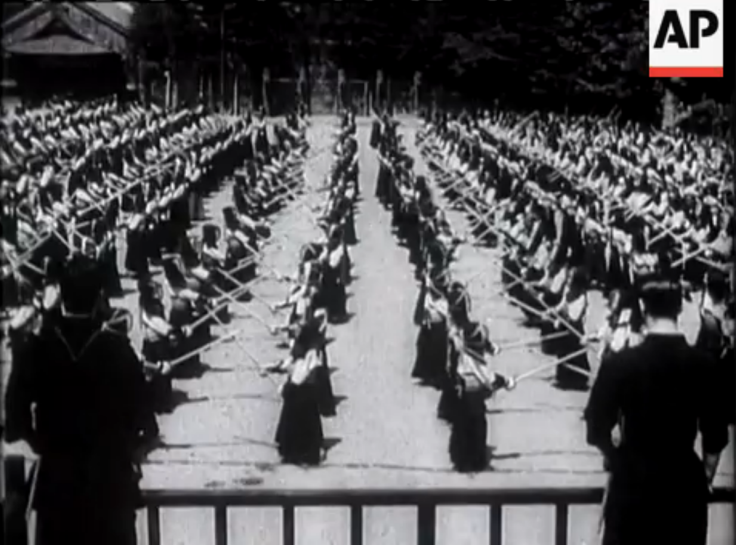
Particularly important is this very short segment titled “Schoolboys ‘Kendo’ at Tokyo.” Distributed in 1934 this film offers an important view of the evolving role of the martial arts in the Japanese educational system during a critical decade. Note that the class has been moved out of the Kendo hall into a training field where the “future soldiers” could acclimate to fighting on bumpy and uneven ground. The mass engagement between the two groups of sword wielding students rushing towards each other at the end of the film is a great illustration of the sorts of reforms (and militarization) of the Kendo curriculum during the 1930s and 1940s discussed by authors like Hurst and Bennett in their respective histories of Japanese swordsmanship. In that respect this is another important historical document.
Note that the overall tone of this discussion is once again one of humor. Even though the practice of the Japanese martial arts by Japanese students should raise no questions of cultural discomfort, humor is still evoked as the dominant paradigm by which a (somewhat disturbing) scene is discussed. One wonders to what degree imperialist attitudes, or possibly fear in the face of rising militarism, contributed to the establishment of this discourse.
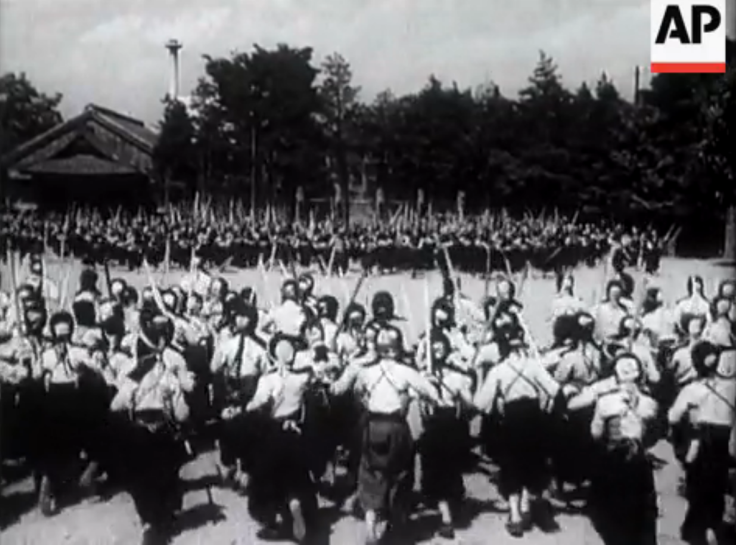
This makes a fascinating contrast to the next two newsreels. They show scenes of Chinese hand combat training. In some ways their historical and ethnographic value is even greater than the preceding films. Yet how would their Western audiences have described what they were seeing on screen?
An exotic form of military training? Certainly. A “martial art”? Possibly, though that term was not yet as popular in the public discourse as it became after WWII. A type of self-defense system that they could learn and study for their own betterment and enjoyment (such as Judo, or possibly even Kendo)? Certainly not.

The first of these films is the longest newsreel in the post, yet it is worth watching in full. The final sequence shows a small formation of soldiers drilling with pudao (horse knives). The form that they are doing is relatively short, clearly illustrated, and I suspect that someone could even teach it to themselves simply by watching this footage. It’s a very nice demonstration.

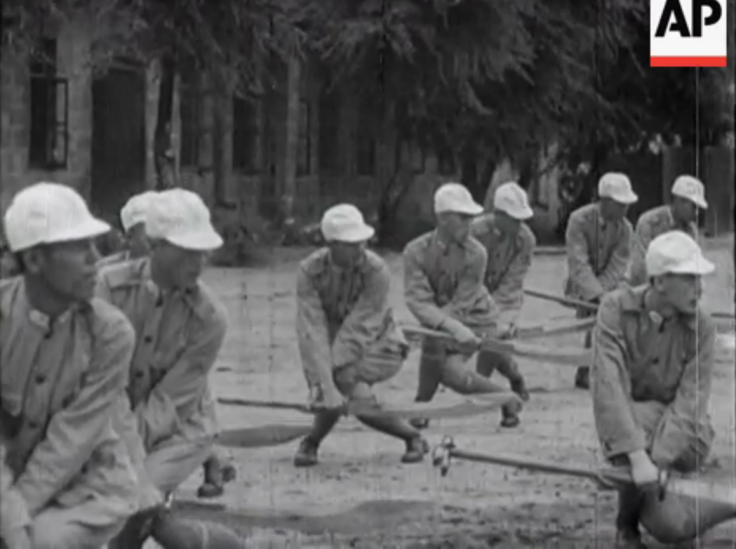
Yet this is not simply an attempt by the imperial West to show the Chinese as militarily weak or backwards. This “training exercise” was introduced only after the audience was shown footage of a warlord and his officers, iconic images of modern troops marching along the Great Wall, and ranks of modern machine-guns being deployed in field exercises. The Chinese military is shown as efficient and well disciplined. One suspects that a Westerner watching this footage would likely equate the sword drill at the end to the Kendo of the Japanese military. Which is probably what both the newsreels producer and the Chinese officers who agreed to be filmed both intended.

A similar pattern is seen in our next film, “Chinese Re-Occupy Great Wall Area.” Dating to 1933 readers of Kung Fu Tea will be pleased to note that the soldiers in this film are drilling with the classic dadao. Whoever produced this footage went to great lengths to try and make a strong impression on the audience. The clip juxtaposes images of a vast field of smartly dressed soldiers with close-ups of individual martial artists shot against the sky. The effect is striking and serves to emphasize the acrobatic elegance of their practice.

The starkness of an individual soldier, engaged in dynamic movement, silhouetted against the sky reminds me of some of John Ford’s iconic WWII footage. Like his more famous counterpart, this director also had an argument that he was trying to bring to the masses. It sought to answer once and for all the persistent questions about the willingness and ability of Chinese soldiers to stand and fight. As if to drive that point home the last sequence is framed by a pair of crossed dadao, inviting the audience to grab one if they dared.
I am interested in these two films because they seem to represent a point of departure in the discussion of the Chinese martial arts in the West. In one sense what audiences are being exposed to remains remote, especially in comparison to Judo and Kendo. It is not hard to find newsreel footage of both Western and Japanese practitioners of those arts in the 1930s. Already they were moving into the realm of cultural appropriation, yet they remain outside of the hegemonic norms and identities. The result is the emergence of exactly the sort of humor in the 1930s that Bowman predicts and explains in the post-1974 era.
In comparison there is nothing funny about the Chinese sword routines. They are introduced not as sporting events or community interest stories. Rather they exist in a grimmer world, one of international conflict, cities falling under martial law and modern armies on the march in Northern Asia. There are no western practitioners of these arts, and so there is not the same sort of cultural discomfort that Bowman describes. Those blades instead represent a forbidding reminder of the challenges facing the Chinese people during the 1930s and 1940s. As such they may make audiences somewhat uncomfortable. Yet there is nothing humorous about what they represent.

Conclusion
Bowman is correct in noting that there is an important relationship between humor and the media driven global spread of the martial arts. However, this post suggests that this basic pattern may have been established much earlier than the 1970s. The newsreel footage demonstrates that these discourses were already in place (and even began to accelerate and evolve) by the 1930s. If you are willing to go back and look at the writing in sports pages many of the same sorts of jokes and subtle concerns about identity masculinity and race can be found in the early years of the 20th century, just as Jujitsu begins to establish its presence in the West.
The Chinese martial arts, on the other hand, do not seem to come into their comedic own until much later. This should not be taken as an indication that they were totally unknown, or that Bruce Lee was the very first Chinese martial artist to do something amazing on film before Western audiences. The newsreel footage that we have reviewed here probably had a striking impact on the audiences that saw it during the early 1930s. Yet it did not generate the uncomfortable humor that Bowman is interested in as it posed no threat to the West’s identity or dominant values. Nor was it remembered decades later.
This provides additional support to Bowman’s central argument that (with some notable exceptions) the comedic discourse around the martial arts does not seem to be driven by pure racism. More important is a critique of how certain types of westerners (often individuals already considered to be marginal by their own societies) seek to live out their fantasies by appropriating alternate models of masculinity or mastery.
What is left unresolved by all of this is the question “why?” Why is there less public engagement with the Chinese arts than the Japanese one from the 1920s-1940s? The immediate danger is that students of martial arts studies will fall back on the old trope that prior to the 1970s the world of Kung Fu was insular because the Chinese themselves were racist. Their arts were not spread because they refused to teach outsiders.
This narrative conveniently ignores the truth that it was the Chinese-American community itself that was being victimized by systemic racism during the 19th and 20th century. It also seems to neglect the fact that while a great many westerners were interested in learning about the Japanese martial arts, very few people seem to have had any interest in the Chinese systems, even when they were advertised to the public through newsreels such as these, performed at the 1936 Olympics, demonstrated by Ivy-League Chinese students as part of popular flood and famine relief programs, or widely seen during Chinese New Year displays in major urban areas.
Ultimately these things were not hidden from the public so much as they were studiously ignored. Bruce Lee turned out to be a pivotal figure not because he was first to teach the arts, but because he managed to change what an entire generation of people wanted.
Yet his was not the first invitation. These newsreels are important as they record early attempts to shape a more favorable public opinion of China in the West by showcasing its traditional martial arts. Together the Dadao and Pudao disrupted the notion that the Chinese people were weak, the so called “sick man of East Asia,” and unwilling to stand and fight back against imperial aggression. They attempted to showcase a highly disciplined army that had mastered both the modern technologies of the machine gun and mechanized transport, while staying connected to the cultured heritage of its past. While America may have awoken to the beauty and potential of the Chinese martial arts only in the 1970s, these newsreels are a fascinating reminder that the hand of Kung Fu diplomacy had first been extended to the Western public at least 40 years earlier.
oOo
If you enjoyed this post see you might also want to read: Zheng Manqing and the “Sick Man of Asia”: Strengthening Chinese Bodies and the Nation through the Martial Arts
oOo
April 18, 2016 at 4:53 am
During the 1950s and 1960s, the British cartoonist JAK (Raymond Jackson of the Evening Standard) often provided cartoons of judo for Budokwai Quarterly Bulletin. Some samples, in context, appear here: http://www.madpc.co.uk/~BJA/PDF/Judo%20Bulletin%20-%20Apr%201962%20N69.PDF . As for earlier connections, from the 1880s on, there were usually several prominent Japanese professional wrestlers on international circuits. Chinese professional wrestlers were much less common, and not nearly as popular.
April 18, 2016 at 9:36 pm
As always, thanks for your insights and the link! I had not seen that before. Any idea why the Chinese wrestlers were less popular? Did they perform poorly, or was there simply less demand to see Chinese athletes on stage?
April 18, 2016 at 10:09 pm
On the mainland, most Chinese Americans were trying to maintain a low profile in those days. At the same time, I don’t think wrestling held the same cultural importance for Chinese as it did for Japanese. But there were a few young men who wrestled. For instance, Leung Tin-kit (Walter Achiu of Honolulu, 1902-1989) was wrestling on the mainland during the mid-century. Here is some footage of him teaming with Kimon Kudo in a tag team match. https://www.youtube.com/watch?v=rLSJO2RWx5A . That said, Achiu is remembered today mostly for being the first person of Chinese ancestry to play in the National Football League. In the Territory of Hawaii, Chinese youths of American ancestry also took up boxing. David Kui Kong Young (1916-2012) was perhaps the most successful Chinese American boxer of the 1930s. On stage, there were a lot of Chinese acrobats and magicians. There were even some white magicians who posed as Chinese. “Chung Ling Soo” is a well-known example of the latter. https://en.wikipedia.org/wiki/Chung_Ling_Soo . Another place one found Chinese fairly early was in the comic books. Terry and the Pirates, for instance, had The Dragon Lady as early as 1934. https://en.wikipedia.org/wiki/Dragon_Lady_(Terry_and_the_Pirates)
April 18, 2016 at 7:29 am
Have you seen this old kendo 1897 video?
April 18, 2016 at 9:34 pm
Thanks Pietro, I have seen that clip before but I never get tired of watching it. Its fascinating to see the guy with the Kusarigama working in the middle of the group!
April 18, 2016 at 8:04 am
This is just a wonderful informative article
April 18, 2016 at 9:34 pm
Thanks!
April 18, 2016 at 11:52 pm
As for what the folks in Peoria thought about CMA in those days, have you taken a look at the stories of tong wars? Pretty lively journalism. And if one didn’t read the yellow press, there was always Edward G. Robinson as a conflicted hatchet man. http://www.tcm.com/mediaroom/video/287702/Hatchet-Man-The-Movie-Clip-Open-Tong-War-Flag.html
January 30, 2019 at 1:42 pm
Hello, Nice to see the topic on martial art. I take a look on article and found nice research on Chinese and Japanese Martial art. This topic cover history of martial art. Thanks for sharing such good information.
January 30, 2019 at 1:44 pm
Hello, Nice to see the topic on martial art. I take a look on article and found nice research on Chinese and Japanese Martial art. This topic cover history of martial art. Thanks for sharing such good information.